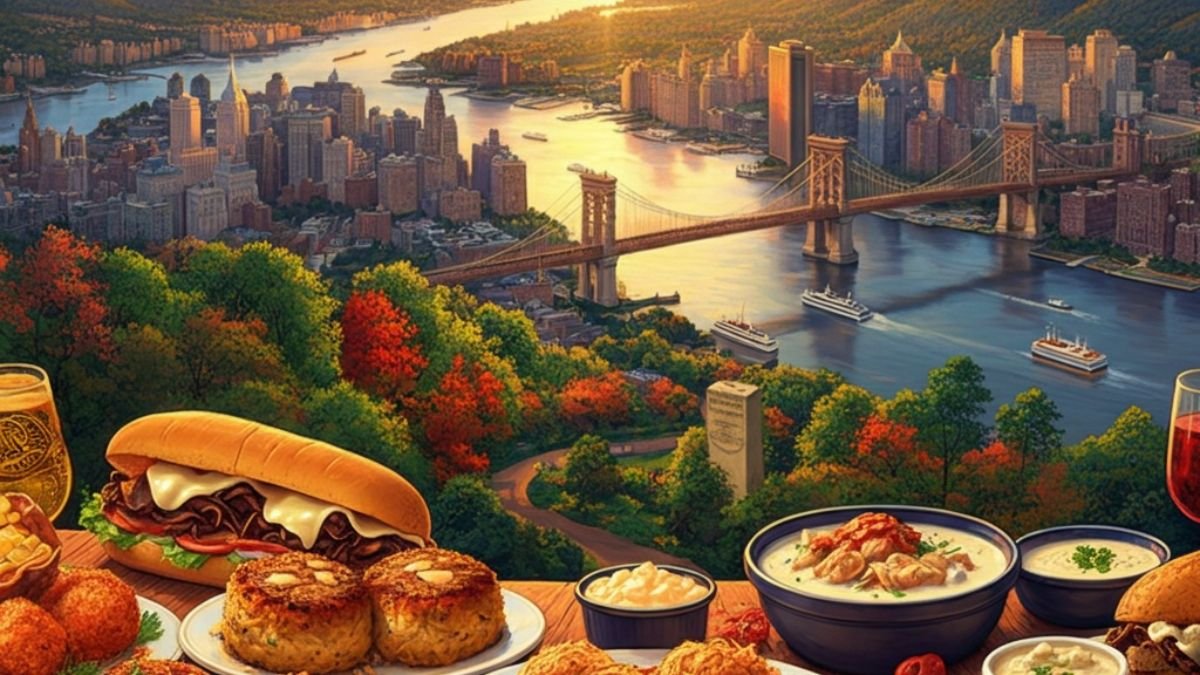When understanding a region’s cuisine, geography is often the missing piece of the puzzle. The Mid-Atlantic region of the United States offers a fascinating example of how landscapes, waterways, and cultural history shape our eating.
This blog explores the geography and relationship to food in the Mid-Atlantic region, uncovering how its fertile soils, navigable rivers, and bustling ports have created a melting pot of culinary traditions. Whether you’re a traveller eager to explore regional foods or a curious foodie, this guide will deepen your appreciation for the Mid-Atlantic’s rich gastronomic heritage.
What is the Mid-Atlantic Region?
The Mid-Atlantic region typically includes the states of New York, New Jersey, Pennsylvania, Delaware, Maryland, and Virginia, along with Washington, D.C. Known for its diverse geography, coastal plains, lush valleys, and the famous Chesapeake Bay characterize the area. These coastal lands are home to bustling port cities like Baltimore and New York and are complemented by fertile farmland and navigable rivers such as the Delaware, Hudson, and Susquehanna.
But how does this unique geography tie into food? Let’s dig in.
What Food is the Mid-Atlantic Region Known For?
From rich seafood dishes to hearty comfort foods, the Mid-Atlantic region’s cuisines reflect a blend of natural resources and multicultural influences. Here are some iconic dishes and food traditions from the region:
- Chesapeake Bay Crab Cakes
The Chesapeake Bay area, rich in blue crabs, has perfected the art of crab cake. These savoury patties are a must-try for seafood lovers.
- Philadelphia Cheesesteak
Known worldwide, the cheesesteak is a definitive staple of Pennsylvania, offering a perfect combination of thinly sliced beef, melted cheese, and soft rolls.
- Manhattan Clam Chowder
This dish is a tomato-based seafood soup that highlights New York’s abundant access to ocean bounty while showcasing a distinct culinary identity.
- Shoofly Pie
Originating from Pennsylvania Dutch communities, this molasses-filled dessert is as sweet as it is historic.
- Smith Island Cake
Maryland’s state dessert, this cake’s multiple layers symbolize the region’s cultural richness.
While these dishes are iconic, the cuisine overall reflects the diversity of the immigrants who settled here—Italian, Irish, German, and Eastern European influences are evident in dishes like cabbage rolls and sour beef with dumplings.
How Geography Shaped the Mid-Atlantic’s Food Culture
Fertile Soil and Agricultural Bounty
The Mid-Atlantic’s fertile soil has long established the region as an agricultural powerhouse. Known as the “Bread Basket Colonies” during America’s early years, the region was famous for producing wheat, corn, and rye. Pennsylvania, for example, was a top exporter of these grains, and they remain core ingredients in the region’s cuisine.
Farmers in the region also grow various fruits and vegetables, such as apples, peaches, and leafy greens, creating a farm-to-table ethos that resonates with modern foodie culture.
Navigable Rivers and Port Cities
The region’s waterways—including the Delaware, Hudson, and Susquehanna rivers—played crucial roles in transporting goods, driving trade, and developing influential cities like New York City, Philadelphia, Newark, and Baltimore.
These rivers made it easy for farmers to send their produce to urban areas, helping to connect rural agriculture with growing urban restaurant scenes. They also allowed the fishing industry along the Chesapeake Bay to supply fresh seafood to the surrounding areas swiftly.
Cultural Melting Pot
The Mid-Atlantic was a gateway for immigrants entering the United States through ports like Ellis Island and Baltimore Harbor. This influx brought incredible diversity to the food scene, with flavours, spices, and culinary traditions from countries like Italy, Germany, Ireland, and Eastern Europe blending seamlessly into Mid-Atlantic cuisine.
For example, German-style sour beef and dumplings are beloved in Maryland, while spaghetti and meatballs quickly found a home in the region’s Italian-American kitchens.
The Economic Impact of Geography on Mid-Atlantic Cuisine
Regional geography has shaped not only what people eat but also how the region’s economy has developed.
- Agricultural Exports
The region’s fertile farmland and access to waterways have made it a hub for exporting grains, produce, and dairy. This infrastructure laid the foundation for Pennsylvania’s identity as a grain exporter while boosting New Jersey’s reputation as the “Garden State.”
2. Seafood Trade Along the Coastline
The Chesapeake Bay remains a vital economic and cultural hub for seafood, particularly blue crabs and oysters. The proximity of urban centres, such as Baltimore and Washington, D.C., to the Bay, ensures a steady demand for fresh seafood.
3. Immigrant-Driven Food Enterprises
Immigrants not only brought diverse cuisines but also contributed to building food-based businesses. For example, Italian immigrants popularized classic pasta dishes and gourmet pizzerias in New York, while Eastern European immigrants introduced their cherished cabbage rolls.
Why the Mid-Atlantic Region is a Must-Visit for Food Lovers
Travellers searching for unique food destinations should set their sights on the Mid-Atlantic. From historic farmlands to dynamic urban food scenes, this region offers a culinary experience steeped in history, diversity, and innovation.
Whether indulging in a seafood feast on the Chesapeake Bay, biting into an authentic Philly cheesesteak, or sampling Michelin-starred restaurants in Manhattan, the Mid-Atlantic’s geography plays a starring role in every dish.
Don’t Miss These Unique Spots in the Mid-Atlantic:
- Maryland Crab Shacks
Enjoy fresh-caught crabs doused in Old Bay seasoning along the Chesapeake Bay.
- Philadelphia Food Markets
Visit the Reading Terminal Market for a whirlwind of flavours and local specialties.
- Hudson Valley Farms
Explore weekend farmers’ markets and farm-to-table restaurants offering seasonal produce.
Where Geography Meets Gastronomy
The geography and relationship to food in the Mid-Atlantic region highlight that the land does more than provide—it inspires. From the sandy beaches that source the freshest seafood to the fertile valleys producing endless grains, how people eat here is deeply tied to where they are.
For travellers, the Mid-Atlantic is more than a destination; it’s an opportunity to taste the result of centuries of cultural blending and agricultural abundance.
What’s your favourite part of exploring a region through its cuisine? Please share your thoughts in the comments below or plan your trip to the Mid-Atlantic to experience it yourself.

